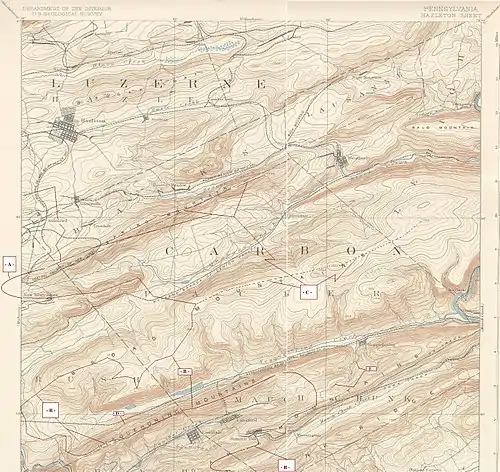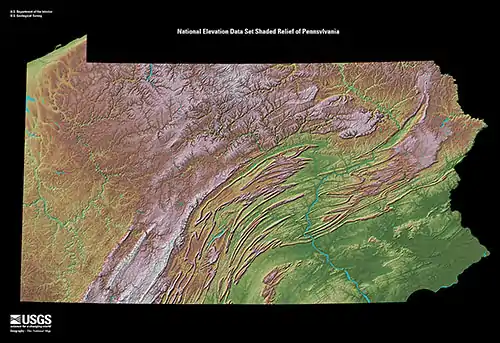Mauch Chunk Mountain
Mauch Chunk Ridge (on older USGS Maps) or Mauch Chunk Mountain is a historically important barrier ridgeline north of the Blue Mountain escarpment and 3rd parallel ridgeline south of the Nesquehoning Creek after Nesquehoning Mountain and Pisgah Ridge[1] in the Ridge-and-Valley Appalachians of Northeastern Pennsylvania. The three lengthy ridges and two valley formations together are literally the first ridges and valleys just south of the Poconos (on the opposite side of the Lehigh River valley)—geological formations which contain some of the richest Anthracite coal bearing sedimentary rocks of Northeastern Pennsylvania. Historically, the first Anthracite mines in America[2] were located atop Pisgah Mountain at Summit Hill and caravanned by pack mule through the Mauch Chunk Creek valley. Then the historic Mauch Chunk and Summit Hill Switchback Railroad, the second railway in North America was built along the Pisgah Mountain side of the same valley—and become quite a tourist attraction and is known as the world's first roller coaster, and would inspire others in purpose built amusement parks. The Mauch Chunk and Summit Hill Switchback Railroad became only a tourist road in the 1890s and thrilled riders until it was liquidated in the 1930s, a casualty of the Great depression.
| Mauch Chunk Ridge or Mauch Chunk Mountain | |
|---|---|
| Highest point | |
| Elevation | 1,501 ft (458 m) displayed map |
| Geography | |
| Location | Carbon County, Pennsylvania, U.S. |
| Parent range | Appalachian Mountains, Poconos |
| Topo map | USGS 40075G8, 1947&'83 Tamaqua (PA) Quadrangle (?) |


The north slopes of the long series of worn peaks feed the minor tributary Mauch Chunk Creek's mouth which opens out easterly into the Lehigh River, and where from ca. 1792 on through its valley, pack mule trails—then North America's second ever rail road— enabled the output of the first coal mines of the southern Anthracite region at Summit Hill, Pennsylvania to be conveyed to the water transport available on the Lehigh River at what is now Packerton, Pennsylvania. A number of early pack mule routes traveled in part along the north faces of the mountain's long ridgeline (12.5 miles (20.1 km)) from Summit Hill and points west.
The ridge is a succession of peaks exceeding 1,501 feet (457.5 m) looming 300–540 feet[3] above the rural bedroom communities now along in the Mauch Chunk Creek valley. The ridge forms the right bank drainage divide on the south and the streams source in the west. The west end of the ridge is named TBDL Geologically, the Mauch Chunk Ridge divide is classed as of minor degree, the watersheds north and south of the ridge enter the same body, the Lehigh, and do so only a few miles apart
Geology
The Mountain is but one average folded mountain in a succession of near parallel ridgelines, where each are made by a succession of peaks of nearly the same height. This Ridge and Valley province is a geological feature that extends from New Jersey into Virginia forming a great barrier of successive valleys. Pisgah Mountain-just across the valley and creek, is located along the southern fringe of northeastern Pennsylvania's Poconos region but is also central to the Southern Anthracite Region of Pennsylvania— known as the site of the Richest Anthracite Seam, in the heart of the Southern Pennsylvania Anthracite Field and the geological province known as the Anthracite Upland section. The ridgeline parallels the escarpment of the Blue Mountain region.
Notes
- USGS MRC: 40075-D6 (1893), Hazelton Quadrangles, Southernmost ridge on USGS topological map of Schuylkill-Lehigh River Drainage Divides, 1893, rev 1893.
- See Lehigh Coal Company of eventual Lehigh Coal & Navigation Company.
- By inspection (estimated from topological maps) - Low altitude is ~900' near Panther Creek, High streets, ca. 1040 ft, Summit Hill, variation is 140 ft, 1440-900=540, 1440-1040=300, which given 12-14 miles of ridge, is close enough to justify the statement.
References
- Alan R. Geyer (1979) "Outstanding Geologic Features of Pennsylvania", Geological Survey of Pennsylvania
- Tom Thwaites (1997) "50 hikes in Eastern Pennsylvania", Third edition
- Art Michaels (2003) "Pennsylvania Overlooks a guide for Sightseers and Outdoor People", Penn State Press